Our toilets are often taken for granted. We do our business, flush and never give them another thought. That is until they start giving us problems, like emptying too slowly. Believe it or not, toilets are pretty complex. A flapper inside is opened when you flush, allowing water to rush through from the tank into the bowl. This rush of water creates suction in the pipes and allows your toilet to empty and then refill with water.
There are many different reasons that your toilet can flush slowly. There could be a blockage somewhere in the pipes, the mechanisms in the tank could be working improperly, or the water level may not be optimal to ensure a fast flush. It could be the cause of waste or debris stuck in the pipes or could be caused by a mineral buildup that is slowing down its flow.
Whatever the reason, a slow flushing toilet can be an annoying problem. Fortunately, this problem can quickly be solved with the help of a plumber. In addition, you can also use some home remedies to fix the toilet. By sourcing some easy-to-find equipment or items from your kitchen pantry, you can repair the toilet and have it flushing correctly in no time.
Whether you call a plumber or fix it yourself, don’t wait too long to fix the slow flushing toilet. Follow these seven tips to get your toilet working correctly and flushing quickly again.
Check for a blockage
If your toilet is flushing slowly, the first thing you should do is check for a blockage. A buildup of waste or toilet paper could cause the pipes to get blocked, or foreign objects may have accidentally fallen into the toilet and blocked up the lines. If you suspect that something may be blocking your toilet, the next step is to use your plunger.
Plunge the toilet
One of the fastest and easiest ways to remove a blockage from your toilet is to plunge it. Insert your plunger into the toilet bowl and create a tight seal around the drain opening. Once you are confident that the seal is tight, plunge both upwards and downwards, ensuring that the plunger never loses contact with the bowl. This plunging motion will dislodge any blockages, and the water will begin to drain. Flush your toilet to ensure that it is flowing freely again.
Use boiling water and dish soap
Regular dish detergent and hot water can help clean out any remaining debris after plunging. This combination will ensure that your bowl and your pipes are sparkling clean. Pour one cup of dish soap into the toilet bowl and allow it to sit for twenty to thirty minutes. Next, boil a kettle of water and carefully pour it into the bowl as you flush it. Flush once more afterward to remove any soap residue and to further flush any last bits of waste and debris out of the lines.
Flush with vinegar
Vinegar is another excellent option to fix a slow-running toilet. Plus, it can be found in most kitchen pantries. Vinegar is mildly acidic and can help dissolve mineral deposits which may be blocking the plumbing. Boil one cup of vinegar and very carefully pour it through the toilet overflow tube inside the tank. It will flush through the rim holes and siphon jet. Let the vinegar sit for half an hour to dissolve any blockages, and then flush the toilet.
Fix the flapper
The flapper is located inside the toilet tank. When the flapper opens, it allows water to flow into the bowl quickly and flushes the toilet. If the flapper can’t open completely, not enough water can pass through fast enough to empty the toilet properly. If this is the case, you must shorten the chain that attaches to the flapper, allowing it enough tension to open fully.
Try some bleach
Bleach is a strong chemical that can easily break down debris and mineral deposits in the toilet. Pour one cup of bleach into the toilet bowl and allow it to sit for fifteen minutes. Afterward, dilute with boiling water and allow to sit for fifteen minutes again. Flush the toilet a few times to allow the complete bleach solution to rinse through, and your toilet should be running quickly once again.
Adjust the water level
Having the correct water level inside your toilet tank can affect how efficiently your toilet flushes. If there isn’t enough water in the tank, there may not be enough power to flush correctly. The water level should be no more than one inch below the top of the overflow pipe. The float ball controls this level. Use a screwdriver to either loosen or tighten the float to adjust the height of the water. The higher the float, the higher the water level will be allowed to rise.





Leave a Reply